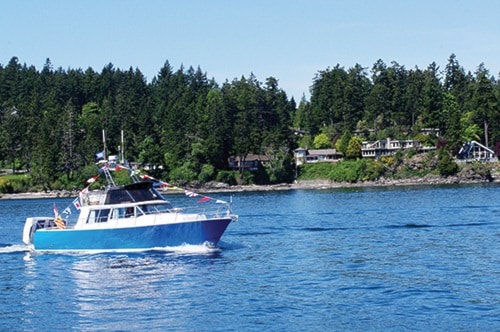The Canadian Safe Boating Council has announced this coming week as Safe Boating Awareness Week across the country.
The Sidney North Saanich Yacht Club and Sidney Royal Canadian Marine Search and Rescue spoke with the PNR on how people can be safe on the water and steps you can take for preparedness.
“One of the first things anybody should have is to ensure that they meet the regulatory requirements of safety equipment that’s required onboard for boating in Canadian and U.S. waters,” said Andrew Quaye, membership director of the Sidney North Saanich Yacht Club.
There is a pamphlet called the Safe Boating Guide that the Canadian Coast Guard produces and hands out. The Guide will give people all of the information needed for the safety equipment required on a boat. This is up to and including the navigational signals like running lights and what type of lights and emergency equipment are needed such as life jackets, flares and sound signalling devices.
“From a personal mariner’s perspective, you want to ensure that you have enough fuel and that your propulsion equipment is in good working order,” said Quaye.
He said there’s an older process that most people haven’t used for years and it follows along the lines of what the aircraft industry uses — a sail plan.
“So it’s always a wise idea just for the very basics of a sail plan to at least advise somebody where you’re going, how many people you have onboard and when you’re planning to come back, and what, if any communication methods you might have.”
Crew Coxswain and boating safety contact for the Sidney Royal Canadian Marine Search and Rescue unit Derek Viggers said impaired boating is their biggest concern when it comes to safety on the water.
He said education is key when it comes to safety.
“Everyone is required to be educated now through the Pleasure Craft Operators Card,” he said adding that education and training is required now for all boating.
In terms of preparedness on the boat, having a cellphone is important so individuals can dial *16 if they need to reach the Coast Guard.
“That is the easiest thing that most people have on the small boats — everyone has a cellphone these days,” said Viggers.
Viggers said also having any hand held radio VHF is also useful.
“You can get in contact with the Coast Guard and also when you broadcast on the distress channel, which is channel 16, you can also be broadcasting to anyone that’s listening…”
Having a GPS onboard, wearing a life jacket or personal flotation device, and the obvious one of no drinking and boating, are also important in terms of safety on the water.
“The boating under the influence, it’s a huge thing. That’ a root cause of a lot of the major problems that we have,” said Viggers.
Both men said being prepared for the weather is extremely important.
“On the water, it could be beautiful and 26 degrees onshore and you get out on the water and the temperature is quite a bit less than the 26 degrees,” said Quaye, adding that the ocean temperature doesn’t vary too much between winter and summer.
“Another part, too, is being aware of cold water risks,” said Viggers, adding sometimes people underestimate the effects of cold water.
Safe Boating Awareness Week runs across North America from May 21 to 27. To learn more, people can visit The Canadian Safe Boating Council at csbc.ca.
